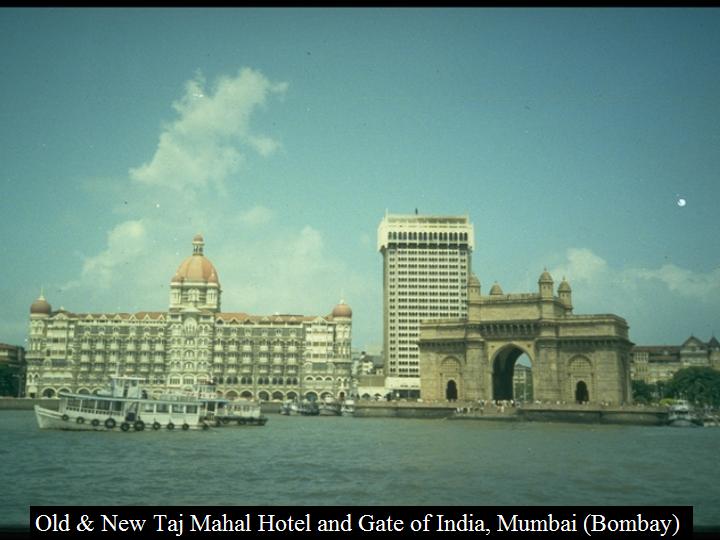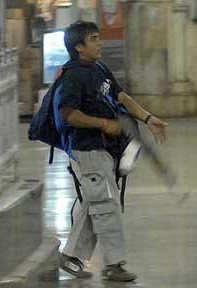
THE GATEWAY OF INDIA BECOMES A DOOR OF DEATH PDF
By Nick Gier
For all my columns on Muslims and Islamic culture click here
Draft chapters of a book "The Origins of Religious Violence"
They [Muslims] shouldn't even be allowed to breed. Whoever they are, women,
children, whoever, nothing is to be done with them but to cut them down.
--a Hindu religious fanatic

If image does not execute go to www.class.uidaho.edu/ngier/MumbaiAttack.htm
The Gateway of India, a basalt arch 85 feet high facing the Arabia Sea, is Bombay's (now Mumbai) most famous landmark. It was built to commemorate the visit of King George V and Queen Mary in 1911. As Emperor and Empress of India they ruled over the entire subcontinent from the Afghan border stretching 1,600 miles to Burma, which was also a British colony. The fact that the British could not pacify the Pashtun tribes of Afghanistan is coming back to haunt the NATO forces there today.
The Mughal emperors had ruled this same territory for over three hundred years, and even though there were periodic persecutions of Hindus and Buddhists, these Muslims rulers extended to them the protections of People of the Book, usually reserved for Jews and Christians only. Under emperors such as Akbar the Great Muslims and Hindus built a rich culture together.
During the Sepoy Mutiny of 1857, Bahadur Shah II was reinstalled as Emperor of India and Hindu and Muslim rebels rallied around him. In retaliation East Indian Company troops sacked Delhi in September 1858, and thousands of civilians, mostly Muslims, were killed and Bahadur Shah was exiled to Burma. The British Crown took direct control of India and introduced a policy of discrimination against Muslims that dramatically reduced their participation in Indian society. Muslims were essentially excluded from the civil service and Muslims literacy dropped to 20 percent over 50 years. Today Indian Muslims, 14 percent of the population, rank lower than their Hindu compatriots in infant mortality, education levels, life expectancy, and per capita income.
Writing for the Los Angeles Times (12-1-08) Asra Q. Nomani reports that "52 percent of Muslim men are unemployed. Almost half of Muslims over the age of 46 cannot read or write. While making up 14 percent of the population, Muslims account for 40 percent of India's prison population. Meanwhile, they hold less than 5 percent of government jobs." Nomani points out that these figures are lower than India’s untouchables, now called Dalits.
In my four stays in India I always made a point to visit the Gateway of India. I would meet my Indian friends for dinner at the nearby Taj Mahal Hotel, a 105-year-old edifice blending Indian, Islamic, and Italian styles. I would also take a rickety boat, one of thousands in the harbor, to the famous Shiva temple on Elephanta Island.
On the evening of November 26, the assistant supervisor of Taj Hotel noticed eight men unloading heavy packs from a rubber dinghy at the base of the Gateway of India. One would think that he would have been suspicious and would have contacted the police. The U.S. has reminded the Indian government that in September 2008 it gave them intelligence about the imminent threat of seaborne attacks from Pakistan. Later that night the Taj supervisor would watch in horror as these men took over his hotel, shot many of residents, and held out against India's top commandos for three days. Before attacking the Taj and Oberoi Hotels and a Jewish center, the terrorists killed 50 people at the main train station.
The terrorists, now linked to Muslim militants fighting the Indian army in the northern state of Kashmir, boarded a cargo ship in Karachi, Pakistan, and then hijacked an Indian trawler and murdered the four fishermen on board. A GPS device left on the trawler indicated that the terrorists had left Karachi on November 23.
A gateway through which British royalty have entered India and Mumbai's multiethnic citizens and tourists have freely congregated will now be known as a gateway of death and terror. The death toll from the attacks is currently at 171, 26 of whom were foreigners (including 6 Americans and 6 Israelis), and 327 wounded.
Since 1970 India has experienced 4,108 terrorist acts that have resulted in over 12,000 deaths. Over the past 16 years Mumbai has been the main target for these attacks. After Hindu fundamentalists demolished the Babri Mosque in Northern India on December 6, 1992, I was there to read about riots all over India and about 900 Mumbai residents, mostly Muslims, lost their lives.
The Mumbai city government and the surrounding state of Maharasthra have been controlled by Hindu fundamentalists since 1995. Together with other right-wing parties, the Bharatiya Janata Party ruled the nation from 1998-2004, and they may return to power if they can convince the Indian electorate that the Congress Party is soft on terrorism. The most radical Hindu nationalists are the Shiv Sena, the Army of Shiva. Their political goal is to rid India of all its native born Muslims, Christians, Sikhs, and Jews. (For them Buddhists and Jains are considered Hindus.) Hindu nationalists were instrumental in changing the names of three major Indian cities--Calcutta, Madras, and Bombay—back to their original names Kolkata, Chennai, and Mumbai.
In 2002 over 2,000 Muslims were killed in riots in Gujarat, a nearby state also governed by Hindu fundamentalists. Muslims were wrongly blamed for setting fire to a train load of Hindu pilgrims, and to this day the government, which has been implicated in the pogrom against the Muslims, has done nothing to arrest the perpetrators. When one of the Taj Mahal attackers defended his actions by saying that Hindus had killed his brothers, he was referring either to the Gujarat massacres or to the conflict in Kashmir. One Hindu religious fanatic boasted about his role in the Gujarat killings: "There was this pregnant woman, I slit her open. They [Muslims] shouldn't even be allowed to breed. Whoever they are, women, children, whoever, nothing is to be done with them but to cut them down."
On March 12, 1993, a bomb went off in the Bombay Stock Exchange killing 50 people. By the end of the day an additional 12 vehicle bombs targeted hotels, shopping centers, Shiv Sena headquarters, one airport, and cinemas. The casualties were much higher than the most recent attack: 257 dead and over 1,400 injured. On August 25, 2003 two car bombs went off at the Gateway of India and a Hindu temple killing 52 and wounding 150. On July 11, 2006 bombs were placed in Mumbai's urban railway cars and the blasts left 209 dead and 700 sent to the hospital.
Police determined that the Kashmiri militants of the Lashkar-e-Taiba (Army of the Righteous, hereafter LeT) and Students' Islamic Movement of India were responsible for these attacks and the most recent one. A group calling itself the Indian Mujahideen has claimed responsibility for recent bombings in four other Indian cities. The LeT was the creation of the Pakistani intelligence agency, and the Pakistani government was forced to outlaw the group after five LeT operatives assaulted the Indian Parliament building in New Delhi killing 11 people on December 13, 2001. Pakistan claims that it has no control over the LeT, but there is a LeT base right outside Lahore that the government could easily shut down. The Islamabad government is also holding terrorists that India wants to try for murder, but it refuses to extradite them.
 The
Muslim Council of Mumbai has refused to bury the nine militants killed in the
most recent attack. The only survivor is a 21-year-old Pakistani (left), who
confessed that he and his comrades had been trained in Kashmir by the LeT. Not
only did they know how to use their AK-47s, but they knew their targets well and
may have had inside help in accessing the hotels through staff entrances. The
militants kept in close contact each other with their Blackberries and their
satellite phone indicated recent calls to a LeT leader in
Pakistan. Survivors on the
scene and phone records suggest that the terrorists, after giving details of
hostages' identities, were directed to kill some and not others. Also in their
backpacks were high explosives that they fortunately did not choose to use. The
fact that these ten men could wreak so much havoc demonstrated not only their
sophisticated training but also a furious determination. Some now speculate
that they must have had an extended network of Indian sympathizers in place to
help them.
The
Muslim Council of Mumbai has refused to bury the nine militants killed in the
most recent attack. The only survivor is a 21-year-old Pakistani (left), who
confessed that he and his comrades had been trained in Kashmir by the LeT. Not
only did they know how to use their AK-47s, but they knew their targets well and
may have had inside help in accessing the hotels through staff entrances. The
militants kept in close contact each other with their Blackberries and their
satellite phone indicated recent calls to a LeT leader in
Pakistan. Survivors on the
scene and phone records suggest that the terrorists, after giving details of
hostages' identities, were directed to kill some and not others. Also in their
backpacks were high explosives that they fortunately did not choose to use. The
fact that these ten men could wreak so much havoc demonstrated not only their
sophisticated training but also a furious determination. Some now speculate
that they must have had an extended network of Indian sympathizers in place to
help them.
India is a microcosm that reflects the world-wide resentment of many Muslims who feel, rightly or wrongly, that their relative low standard of living is the result of Western imperialism. These grievances do not in any way justify terrorist acts, but they must be taken into consideration if any long term solutions are to be reached. For South Asia specifically the full cooperation of Pakistan is imperative.
At the beginning of the 20th Century many Indian Muslims thought that the solution was a separate Muslim state in South Asia. Over Gandhi's strenuous objections, Muslim nationalists achieved their goal 1947 with the formation of the state of Pakistan. The Partition of India led to the deaths of millions of Hindus and Muslims and set the stage for four wars, each of which India won easily.
Perhaps India's biggest mistake was to support the Hindu maharaja's decision to make Muslim majority Kashmir a part of India rather than Pakistan. In this beautiful mountainous region, the brightest jewel in the crown of British India, Pakistani and Indian troops still face each other across a Line-of-Control and militant groups such as LeT undermine stability in the area as well as send their men to targets in India and Pakistan. Kashmiri militants are the main suspects in a September 25th attack on the Marriott Hotel in Islamabad that killed 54 and wounded 270.
Even if British India had stayed together, tensions between Muslims and Hindus would still have festered. When the last British troops sailed from the Gateway of India, they left in their wake not only the discriminatory policies against Muslims, but the missionary idea of a pure religion that required the rejection of all other faiths. My own research shows that Hindu and to lesser extent Muslim fundamentalists learned their rigid views of religion from the West, and their 20th Century followers are expressing this religious dogma in the most vicious and destructive ways possible.